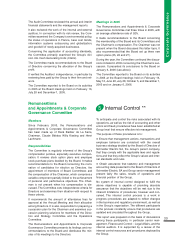APC 2005 Annual Report Download - page 44
Download and view the complete annual report
Please find page 44 of the 2005 APC annual report below. You can navigate through the pages in the report by either clicking on the pages listed below, or by using the keyword search tool below to find specific information within the annual report.
42
Acquisitions Committee, New Products Committee
Proposed business acquisitions and development pro-
grams must be submitted to the Acquisitions Commit-
tee or the New Products Committee for review, prior to
being presented for approval at the appropriate man-
agement level as described above. The two commit-
tees are made up of representatives of the main
departments involved in the projects.
Quarterly management reviews
Group senior management (comprising the Chief
Operating Officer, the Executive Vice-President,
Finance & Control - Legal Affairs and the Executive
Vice-President, Human Resources & Communication)
performs a comprehensive review of the activities and
results of the Operating and Corporate Divisions four
times a year. The review covers the status of the main
action plans in the areas of business growth, opera-
tional efficiency and human capital management, as
well as year-to-date results and forecasts for the
remaining quarters.
Monthly management reporting
Group senior management holds monthly meetings to
review the monthly management accounts of the
Group and the individual units.
In addition, financial controllers from the Operating
Divisions and Finance and Control – Legal Affairs
department review the units’ performance and princi-
pal transactions monthly.
Tracking of priorities set by the new2Company
Program
In January 2005, Schneider Electric launched the
new2Company program, which focuses on three pri-
orities for which the Group has identified significant
potential for improvement: growth, efficiency and peo-
ple. The program’s indicators, measured monthly, con-
cern:
Growth achieved by new activities and new products.
The efficiency of such critical processes as cus-
tomer satisfaction, supply chain, IT and purchasing
and production localization.
Employee development (training, occupational
health and safety, etc.).
new2’s priorities correspond to major processes for
which the Group has committed to a maximum level of
efficiency and quality.
Senior management tracks these indicators monthly.
Action plans are deployed immediately when areas of
risk or improvement are identified.
Financial review meetings
The financial position of all Group companies is
reviewed once a year by Group Finance and Control -
Legal Affairs. The process includes, for each unit:
An analytical review of the balance sheet and of
capital employed.
An analytical review of working capital and customer
credit.
An analysis of financial risks (liquidity, currency,
counterparty and credit risks).
A review of compliance with internal rules governing
intercompany payments and transfer pricing.
A review of the membership of the unit's Board of
Directors or equivalent.
Monthly Treasury Committee meetings
This Committee, chaired by the Executive Vice-Presi-
dent, Finance and Control - Legal Affairs, reviews the
Group's monthly cash position, foreign currency posi-
tion and financing capacity.
Foreign currency transactions for all entities are man-
aged at Group level, except for those involving soft
currencies. Schneider Electric has established internal
control rules governing foreign exchange exposure –
only the operating receivables and payables of each
entity and intercompany financial receivables and
payables (dividends, loans and borrowings) are
hedged – and the accounting treatment of foreign cur-
rency transactions.
b) Specific procedures applicable to certain
types of risks or transactions
Integration of newly-acquired businesses
The integration of newly-acquired businesses is a
process that extends over a period of 6 to 24 months
depending on the type and size of the new entity. The
integration scenario for each acquisition varies
depending on whether the business was acquired to
strengthen the Group's existing lineup, extend the line-
up or penetrate a new segment.
All told, there are five scenarios ranging from total
integration to separate organization reporting to sen-
ior management. Depending on the strategic objec-
tive, a matrix is drawn up showing the required level of
integration for each of the newly-acquired business's
core functions, i.e. front office (sales force and brand),
back office, R&D, corporate functions and manage-
ment reporting.
An integration plan is drawn up for each acquisition
and is implemented by an integration manager who
reports to a Steering Committee. The Steering Com-
mittee meets monthly during the integration plan
development phase, and quarterly once the integra-
tion plan has been approved.
New product development
The New Products Committee allocates resources
among new product development, range management
and technological research.
Management processes for technological projects
have been harmonized throughout the Group to allow
more effective tracking of resource allocation and
return on investment.
Industrial property
The patents developed or purchased by the Group are
tracked by the Industrial Property team within the
Finance and Control - Legal Affairs Department.
























